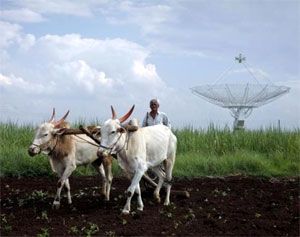This technology has potential uses in many sectors but India needs to invest more in R&D to reap the benefits of this fantastic science, says Surinder Sud.
 India was a late starter in exploiting the immense potential of biotechnology. The same seems to be true for nanotechnology, but some recent initiatives in capacity building in this field may help make up some of the lost ground. Going by the assessment of the National Academy of Agricultural Sciences (NAAS), nearly 90 per cent of nanotechnology-based patents and products belong to just seven countries — the US, Germany, France, Japan, Switzerland, South Korea and China.
India was a late starter in exploiting the immense potential of biotechnology. The same seems to be true for nanotechnology, but some recent initiatives in capacity building in this field may help make up some of the lost ground. Going by the assessment of the National Academy of Agricultural Sciences (NAAS), nearly 90 per cent of nanotechnology-based patents and products belong to just seven countries — the US, Germany, France, Japan, Switzerland, South Korea and China.
India figures nowhere. Nanotechnology has remarkable applications in a variety of spheres, including agriculture, animal husbandry and natural resources management. But investment in research and development in this fantastic science needs to be raised to reap its benefits.
Nanotechnology deals essentially with extremely small or nano (the Greek word for dwarf) matter measuring one to 100 nanometre or nm (one nm is equivalent to one-billionth of a metre). The genesis of this technology, validated by observations, is that on being contracted to nanoscale a substance acquires properties that are different from its original traits.
This attribute is exploited by nano-technicians to evolve gainful products and processes that are hard to develop through conventional means. For instance, when inputs such as water, fertiliser and pesticides are delivered in nanoscale at appropriate spots in the soil or plants, they yield far better results than those obtained from their normal bulk application.
The same is true for the use of nano drugs on farm animals or human beings since the active ingredients of these drugs strike precisely at targeted pathogens. This technique, therefore, proves highly efficient and cost-effective.
NAAS describes nanotechnology as modern history’s “sixth revolutionary technology” in its policy paper (No 63) “Nanotechnology in Agriculture: Scope and Current Relevance”. The other five technology-driven revolutions are: industrial revolution in the mid-1700s, nuclear energy revolution in the 1940s, green revolution in the 1960s, information technology revolution in the 1980s, and biotechnology revolution in the 1990s.
The potential uses of nanotechnology in the farm sector are many and quite varied. The notable ones that can be tapped in the near future include: slow release and efficient delivery of water, plant nutrients, pesticides and livestock drugs; monitoring of soil and plant health through nano-sensors; detection of pests; and removal of soil and water contaminants with nano-magnets. It has even been used in laboratories to produce “vegetarian” chicken or goat meat that has the same taste, texture and nutrition as actual meat. Designer eggs have also been produced.
A Nano Mission Project was launched in India in the 11th Plan to build research and development capabilities and infrastructure in nanotechnology. The 12th Plan aims to take this initiative forward with the lofty ambition of making India a “global knowledge hub” in nanotechnology. To this end, a dedicated institute of nano science and technology is being set up, and post-graduation programmes (M Sc and M Tech) in 16 universities and institutions across the country will be launched. Besides, the mission is funding about 235 individual scientist-centric research projects on fundamental research in nano-systems.
The Indian Council of Agricultural Research has also constituted a nanotechnology platform to spur the use of nanotechnology in agriculture. This is mandated to synthesise nano-particles for farm use, develop quick diagnostic kits for plant diseases and pests, stabilise organic matter in soils, evolve efficient ways of using farm inputs and devise nano-food systems.
However, biosafety has to be the watchword in nanotechnology research and its application. If mishandled, nano products and processes may pose health and environmental risks. Food and other products produced with nanotechnology need to be evaluated against possible hazards before being approved for commercial use. NAAS has counselled appraisal of nano particles’ effects even on non-targeted material, such as soil-borne beneficial micro-flora, natural enemies of crop pests and other natural biological weed and pest-control systems.
Thus, there is a need to put in place a carefully conceived regulatory mechanism for nanotechnology. Creating public awareness of any possible merits and demerits of nano-products is imperative to stave off resistance from environment activists of the kind some biotechnology products have come across. This should be part of our overall strategy to promote nanotechnology to catch up with advanced countries.












 © 2025
© 2025